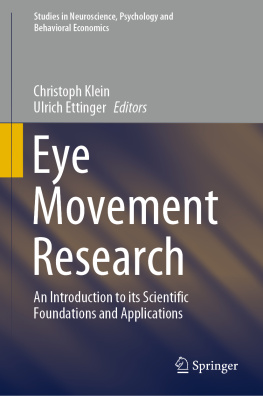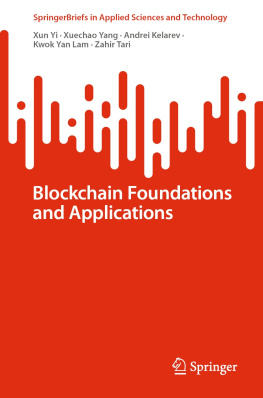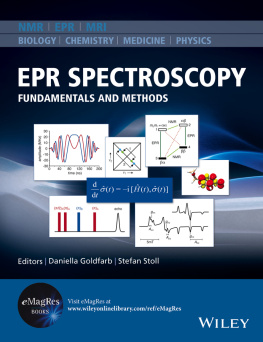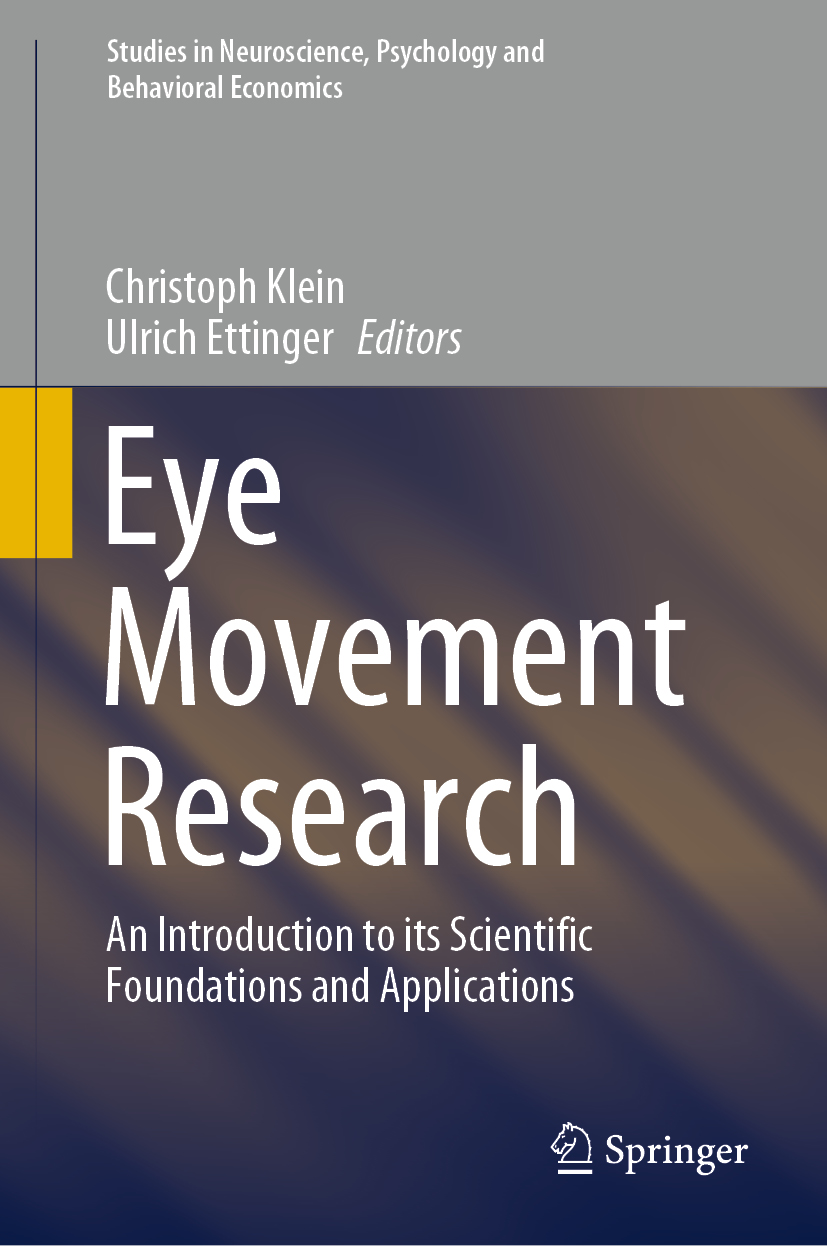Studies in Neuroscience, Psychology and Behavioral Economics
Series Editors
Martin Reuter
Rheinische Friedrich-Wilhelms-Universitt Bonn, Bonn, Germany
Christian Montag
Institut fr Psychologie und Pdagogik, Universitt Ulm, Ulm, Germany
This interdisciplinary book series addresses research findings and methods in the intersection of the fields of neuroscience, psychology and behavioral economics. At the core of the series is the biological basis of human decision making, including aspects of an economic, cognitive, affective and motivational nature. Contributions from fundamental and applied sciences are equally represented and cover a broad range of scientific work, reaching from mathematical modeling to scholarly introductions into new research disciplines and related methodologies and technologies (e.g. genetics, psychophysiology, brain imaging, computational neuroscience, animal modeling). The book series presents empirical and methodological scientific innovations bridging the gap from brain to behavior. It includes research works in neuroeconomics and neuro-information systems (e.g. human-machine interaction) as well as social, cognitive and affective neuroscience, which aim at enhancing the understanding of human decision making.
More information about this series at http://www.springer.com/series/11218
Editors
Christoph Klein and Ulrich Ettinger
Eye Movement Research
An Introduction to its Scientific Foundations and Applications
Editors
Christoph Klein
Department of Child and Adolescent Psychiatry, University of Freiburg, Freiburg, Germany
Department of Child and Adolescent Psychiatry, University of Cologne, Cologne, Germany
Ulrich Ettinger
Department of Psychology, University of Bonn, Bonn, Nordrhein-Westfalen, Germany
ISSN 2196-6605 e-ISSN 2196-6613
Studies in Neuroscience, Psychology and Behavioral Economics
ISBN 978-3-030-20083-1 e-ISBN 978-3-030-20085-5
https://doi.org/10.1007/978-3-030-20085-5
Springer Nature Switzerland AG 2019
This work is subject to copyright. All rights are reserved by the Publisher, whether the whole or part of the material is concerned, specifically the rights of translation, reprinting, reuse of illustrations, recitation, broadcasting, reproduction on microfilms or in any other physical way, and transmission or information storage and retrieval, electronic adaptation, computer software, or by similar or dissimilar methodology now known or hereafter developed.
The use of general descriptive names, registered names, trademarks, service marks, etc. in this publication does not imply, even in the absence of a specific statement, that such names are exempt from the relevant protective laws and regulations and therefore free for general use.
The publisher, the authors and the editors are safe to assume that the advice and information in this book are believed to be true and accurate at the date of publication. Neither the publisher nor the authors or the editors give a warranty, expressed or implied, with respect to the material contained herein or for any errors or omissions that may have been made. The publisher remains neutral with regard to jurisdictional claims in published maps and institutional affiliations.
This Springer imprint is published by the registered company Springer Nature Switzerland AG
The registered company address is: Gewerbestrasse 11, 6330 Cham, Switzerland
Preface
The recording of eye movements is amongst the most versatile methods to study human information processing and behaviour. The range of applications is immense and so is the range of research questions that have been addressed with this method. The eye-tracking community seems to be ever growing and is well represented at conferences or in monographs or handbooks on the science of eye movements.
Despite the growing success of the science of eye movements, it occurred to the editors of this volume that one aspect is conspicuously missing: An introduction to the study of eye movements for beginners in the field, be it Masters or doctoral students, post-docs or professors. Therefore, beginners in eye movement research, but also those who wish to refresh their knowledge or deepen or broaden their understanding of eye movement research, are the target readership of this textbook.
World-leading experts in their respective fields of eye movement research have contributed to this textbook by providing chapters. Additionally, authors, expert reviewers, the editors and a large group of student reviewers have taken care to make the individual chapters didactically accessible to newcomers in this field.
Part I of this textbook is dedicated to the basics of eye movement research and explains the main types of eye movements relevant in this field, including fixation-related eye movements, different types of saccadic eye movements and smooth pursuit. This part also covers the relationship between eye movements and perceptual or attentional processes as well as reading.
Part II explains the methodological versatility of eye movement recordings as a stand-alone or combined technology. After an in-depth introduction to recording techniques, its possibilities and potential pitfalls, two chapters deal with innovative and advanced approaches to model and quantify eye movement data. Further chapters introduce the fields of pupillometric research, the investigation of eye movements in brain imaging, in the field or in research with animals.
Part III of this textbook then provides introductions to the main clinical applications of the eye movement technology in child, adolescent and adult psychiatry, neurology and pharmacology. These chapters illustrate how the investigation of eye movements can identify and help understand deficits and processing biases in psychiatric populations aid the diagnosis of functional impairments in neurological disorders or trace the actions of pharmacological agents in real time.
Finally, Part IV provides examples of industrial applications of the eye movement technology, including its use in marketing research and neuroeconomics, when improving the usability of websites and other products, when investigating vehicle control or as an interface between humans and computers.
Collectively, these chapters provide an insight into the breadth of eye movement research and help the newcomers in these fields in gaining expertise. This volume is the outcome of the work of more than a hundred scientists and students to whom the editors are immensely grateful.
Christoph Klein
Ulrich Ettinger
Freiburg, Germany Bonn, Germany
Advisory Board
Antoniades, Chrystalina A., Nuffield Department of Clinical Neurosciences, Oxford University, Oxford, UK
Bracewell, Martyn, Schools of Medical Sciences and Psychology, Bangor University, Bangor, UK; Walton Centre for Neurology and Neurosurgery, Liverpool, UK
Bremmer, Frank, Department of Neurophysics and Center for Mind, Brain and BehaviorCMBB, University of Marburg, Marburg, Germany
Corr, Philip, School of Arts and Social Sciences, City, University of London, London, UK
Crawford, Trevor, Department of Psychology, Faculty of Science and Technology, Lancaster University, Lancaster, UK













